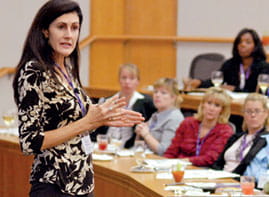Why the market went south
Kellogg finance professor Sergio Rebelo dissects the economic downturn
By Matt Golosinski10/16/2009 - “It looks like a nightmare,” Sergio Rebelo said, gesturing to one of the slides in his Oct. 13 presentation before a standing-room-only audience in the James L. Allen Center.
On the screen was an impossibly complex web, nearly black with entanglements, under the title “collateralized debt obligations,” the now-infamous asset-backed security that many consider a principal culprit in the recent global liquidity crisis.
This was just one piece in a larger gloss that Rebelo, the Tokai Bank Professor of Finance, used to explain the forces behind the 2008-2009 U.S. recession. Taking a historical approach to financial crises dating back to the 19th century, Rebelo showed how various elements — from central bank monetary policy to securitization to the real estate market — have interacted in recent years to impact the economic system.
During an hour-long discussion, Rebelo highlighted financial tools that he said worked. For example, he called mortgage-backed securities a “great idea” to diversify risk and said that securitization, a strategy to aggregate debt into “pools” of securities that are then resold, remained an important component of modern finance. But when it came to other practices, such as excesses associated with CDOs, Rebelo was unsparing: “Creativity and banking are two words that should never go together,” he said.
Citing CDOs as a key cause of the financial crisis, Rebelo pointed to the repackaging of debt — including many home loans — into so-called “toxic assets” that banks could not sell. As a result, a strategy initially designed to distribute and thereby minimize risk ended up increasing it instead. These instruments attempted a sort of “financial alchemy” that Rebelo said backfired when banks had to assume too much of the poor-quality securities while selling off the less-risky ones to investors.
While Rebelo admitted that most economists are reluctant to make firm predictions about real-time economic events, preferring to wait until all the data become available, he did offer some upbeat news rooted in historical fact.
Producing data tracking U.S. real per capita GDP from 1870 until 2000, Rebelo showed evidence that the market always “reverts to trend — even after the Great Depression.” He also discussed how, prior to the creation of the U.S. Federal Reserve System in 1913, there had existed no “lender of last resort.” As a result, financial crises were routine. By the 1930s, he added, the introduction of federal deposit insurance and other mechanisms to prevent bank runs have meant that U.S. recessions have tended to be less frequent and less severe than they were during the early part of the 20th century. The trade-off that government demanded in offering this stabilization to the banking system, said Rebelo, was more oversight.
Without such assurances, though, Rebelo said that history shows that banks tend to fail when people lose confidence in the system and withdraw their funds. “Putting your money under the mattress is about the worst thing you can do for the financial system,” said Rebelo. “You take the money out of play.”
So how well is current monetary policy working to stabilize the banking system? Is the U.S. headed for a quick recovery?
Yes. And no.
Rebelo cited evidence from two different camps to suggest that the answer is not easily determined. Some optimistic experts hold that the larger the recession, the faster the economic recovery. Pessimists, however, note that recoveries from recessions associated with financial crises are often slow to gain traction.
Even massive federal intervention, such as the American Recovery and Reinvestment Act of 2009 — the stimulus bill designed to jumpstart the U.S. economy — offer no guarantees, Rebelo explained. If citizens view the stimulus as ultimately requiring more tax revenue, they may begin saving more money now in anticipation of that expense — effectively offsetting the desired stimulus.
Over the next year, Rebelo said, forecasts from the International Monetary Fund predict only very modest economic growth for the U.S. and Europe — 1.5 percent and 0.3 percent respectively — while China (9 percent) and India (6.4 percent) may see more sizable increases.
Despite the gloom, Rebelo said that companies can increase their success by understanding consumer behavior during recessions and then adapting product mix, inventories and advertising accordingly. For instance, the knowledge that consumers tend to reduce big durable goods purchases, like cars and appliances, during downturns and instead shop more frequently for smaller sizes and lower quality can be helpful to companies. Other useful strategies include setting appropriate promotions, targeting younger consumers with stable jobs and even focusing on efforts to build social capital and brand loyalty.






